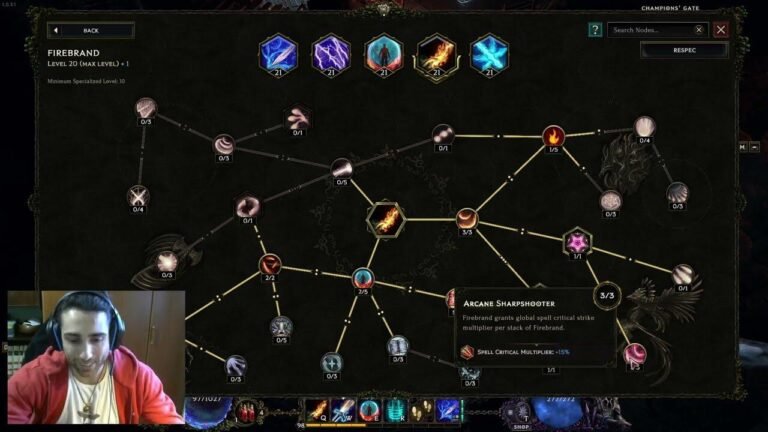Dialing up the nerd-o-meter to 11, here’s your lowdown on the Last Epoch loot-nado: Base damage and its modifiers are like milk and cookies – separately delightful, but combine ’em for a magical munch. Crank up those numbers with modifiers and watch your enemies poof like a ghost at a garlic festival! 🤯👻🧄 #DamageDessertCombo #ModifierMadness #LootNado
Table of Contents
Understanding the Basics of Damage in Last Epoch 🛠️
What Constitutes Base and Additional Damage?
Damage in games often gets confused when discussing flat and percentage increases. In Last Epoch, damage should be approached considering the base damage — the foundation to which modifiers apply. It’s crucial to build your damage upon a solid base to maximize your offensive capabilities.
The Power of Damage Modifiers
Modifiers such as melee or necrotic damage can significantly augment your base damage in Last Epoch. These modifiers compound, multiplying the base amount and resulting in exponential growth of your total damage output.
Identifying the Best Affixes for Your Damage Build ⚔️
Melee vs. Spell Damage Affixes
Depending on your character’s focus (melee or spell), you’ll want to look for specific affixes. Melee characters should lean more towards flat damage modifiers, while spell-casters may benefit more from percentage increases due to different scaling mechanisms.
Weapon Affixes and Their Role in Maximizing Damage
Weapons in Last Epoch can be customized with affixes to provide flat damage, drastically boosting the damage potential. Similarly, other gear slots offer different types of affixes to complement this.
| Key Affixes for Damage Types | Equipment Slots |
|---|---|
| Flat Damage Affixes | Weapons |
| Percentage Damage Modifiers | Amulets, Belts, Rings |
Utilizing Damage Modifiers in Skill Trees and Equipment
Skills in Last Epoch can include damage modifiers that could further increase damage output. Understanding which modifiers stack multiplicatively or additively is essential for optimal damage scaling.
Maximizing Damage through Elemental Penetration and Shred 🌩️
How Penetration and Shred Impact Damage
Elemental penetration, such as lightning penetration, adds a layer of complexity to damage calculations by bypassing enemy defenses, which can significantly amplify your effectiveness in combat.
The Synergy between Shred and Penetration
Shred functions by reducing enemy resistances, potentially benefiting both you and your teammates. In contrast, penetration targets a specific type of damage.
| Damage Enhancement Methods | Impact on Enemies |
|---|---|
| Shred | Reduces resistances |
| Penetration | Ignores specific defenses |
Choosing the Right Damage Type for Your Build
Your build’s focus on a particular damage type, like lightning or fire, should influence your choice between shred and penetration, with each providing unique advantages.
Investigating the Efficacy of Different Damage Types 💥
Evaluating Skills and Damage Over Time
Understanding the nuances between hit-based damage and damage over time can drastically affect your build’s performance, with some skills excelling in specific situations.
The Role of Ailment Scaling and Cast Speed
Building around ailments and cast speed can exponentially increase your damage, particularly when focusing on applying effects as quickly as possible.
Constructing a High-Damage Character in Last Epoch 🔨
Creating a Base for Exponential Damage Growth
A solid base of flat damage is fundamental to multiplying damage with various modifiers. Starting with a decent base ensures you’ll benefit more from percentage-based increases.
Leveraging Multipliers to Surge Damage Output
Multipliers play a critical role in enhancing damage. Identifying and applying hidden multipliers within your build can elevate performance.
Inspecting Additional Damage Sources and Their Impact 📈
Recognizing the Importance of Additional Damage Modifiers
Additional damage sources, such as critical hits or elemental damage, combine into a single pool that can dramatically increase your total damage output.
The Role of Attributes and Their Relation to Damage Percentages
Attributes can significantly boost your damage, with each point invested offering a percentage increase, complementing other damage modifiers.
Integrating Knowledge of Damage Mechanics into Practical Application ⚙️
Navigating Damage Calculations in Combat
Comprehension of damage calculations can propel a build from mediocrity to excellence. Mastery of these mechanics enables you to strategize effectively, resulting in more potent and efficient gameplay.
Advancing Through Experimentation and Skills Synergy
Testing different skills, modifiers, and affixes uncovers powerful combinations that others may overlook. Finding synergies that others have missed decimates your enemies more effectively.
Key Takeaways
Massive damage in Last Epoch hinges on understanding and leveraging various mechanics like base damage, modifiers, penetration, shred, damage over time, and multipliers. Each aspect contributes to the complete picture of maximizing your potential for dealing damage.
| Key Takeaway | Reason for Importance |
|---|---|
| Base Damage Foundation | Necessary for scaling with modifiers |
| Choice of Affixes | Dictates whether you focus on flat or percentage damage |
| Elemental Penetration vs. Shred | Impact on bypassing enemy defenses |
| Balancing Hit-Based and Damage Over Time Effects | Affects strategy for different combat scenarios |
| Utilizing Attributes and Additional Modifiers | Increase overall damage output |
Frequently Asked Questions
Q1: How do I choose between flat and percentage damage modifiers?
A1: It depends on your character’s focus; melee builds generally benefit more from flat damage, while spell-casters should aim for percentage increases.
Q2: What is the difference between shred and penetration?
A2: Shred reduces enemy resistances and can benefit multiple attackers, whereas penetration bypasses specific defenses for your attacks only.
Q3: How can I ensure my damage scales effectively?
A3: Start with a solid base of flat damage and strategically apply multipliers and additional modifiers for exponential growth.





![Sure, here’s the rewritten text:
[Last Epoch] Guide: Mastering the Detonating Arrow Explosive Trap Marksman Build for Handling 600+ Corruption with Ease!](https://lastepochbuilds.net/wp-content/uploads/2024/03/WP-20240313043047-864193-768x432.jpg)

